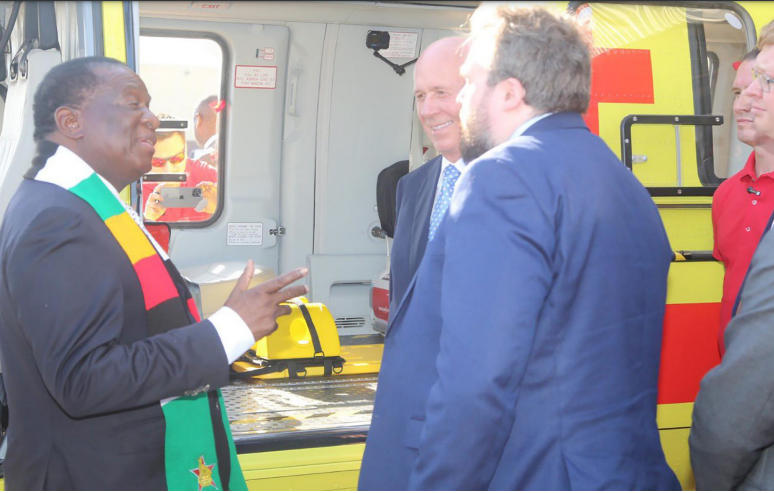AFTER pulling out of the much-hyped US$3 billion Darwendale platinum mining deal in Zimbabwe two years ago, Rostec, a Russian state-owned conglomerate, has chosen a low-hanging fruit — the supply of equipment to Zimbabwe.
NATHAN GUMA
Rostec is a massive Russian state-owned enterprise formed to consolidate the nation’s technological, aerospace, and military-industrial expertise.
It is also a holding company whose subsidiaries are engaged in a wide range of industries, including automotive, defence, aviation, and metals.
This week, the company delivered 18 of the 32 Kazan Ansat helicopters, which President Emmerson Mnangagwa says will be used for ambulance, disaster management, policing and wildlife protection duties.
President Emmerson Mnangagwa said he personally sourced the helicopters from Russia’s Vladimir Putin.
In 2014, Rostec together with Vi Holding and Vneshekonombank formed a consortium that sought to invest in developing the Darwendale platinum field in Zimbabwe with the Zimbabwean military.
However, the Great Dyke Investments (GDI) project in Darwendale, 65 kilometres west of Harare, which has the potential to become one of the world’s biggest platinum mines with capacity to resuscitate Zimbabwe’s economy, has been in limbo.
As previously reported by The NewsHawks, the Russians pulled out of the deal in 2021 due to a plethora of problems which include corruption, mismanagement, mistrust, and poor planning. After the deal crumbled, the Russians ceded their 50% stake in the company to Zimbabwe’s Kuvimba Mining House.
The other 50% is owned by Landela Mining Venture linked to local tycoon Kudakwashe Tagwirei who is closely associated with Mnangagwa and his family.
Kuvimba Mining House’s shareholding is largely unknown, with 65% owned by government and 35% by ghost shareholders. The company now controls 50% of GDI.
Tagwirei was last year placed on additional US sanctions by Washington’s Office of Foreign Assets Control (Ofac), together with his wife Sandra Mpunga, Nqobile Magwizi, Fossil Agro, Fossil Contracting, and Obey Chimuka.
Tagwirei was first sanctioned in 2020 over corruption allegations.
Initially, the platinum project was owned by a consortium of Zimbabwean investors operating under the name Pen East, 30% controlled by the military’s Old Stone Investments and 20% by the state-owned Zimbabwe Mining Development Corporation (ZMDC), before Tagwirei bought that 50% stake, and Russian investors, including VI Holdings, Rostec and Vnesheconombank.
South Africa’s Impala Platinum, which owns Zimplats, the country’s biggest platinum project, was approached to buy a stake in GDI. However, the move failed due to GDI’s opaque shareholding structure, especially regarding Kuvimba. Landela paid US$21.5 million for a stake in GDI.
The deal was not transparent. The project was commissioned by the late former president Robert Mugabe in September 2014 in a high-level ceremony also attended by visiting Russian Foreign minister Sergei Lavrov.
Located on the mineral-rich Great Dyke belt, it is one of the biggest Platinum Group Metals deposits in the world. A bankable feasibility study undertaken in 2017 by African Export-Import Bank showed the project had a potential to contribute Zimbabwe’s economic turnaround.
Peak production of the mine was expected to be 860 000 ounces per annum, translating to almost US$1 billion. The 6 500-hectare mine life expectancy is 40 years. GDI initially said the mine would be developed in three phases, with the first running from 2014 to 2017, entailing exploration, infrastructure development and commissioning of mining facilities.
The second phase from 2018 to 2021 was expected to include establishment of a new mine and expansion of concentration capacity to produce 530 000 oz of platinum per year. The third and full development phase would run from 2022 to 2024, and see the expansion of platinum production to 800 000 oz per year.
The cost of mining and establishment of a smelter was estimated at US$3 billion, but would rise to US$4.8 billion after the setting up of a refinery between 2022 and 2024. Finance minister Mthuli Ncube awarded GDI a special mining lease under which a range of taxes will not have to be paid for five years due to its political connections.
By the end of 2021, the Russians had started to strategically pull out of the mine site.
The GDI project was expected to create at least 8 000 high-skill jobs at its peak, producing four million tonnes of ore per annum.
According to GDI vice-chair Igor Higer, that would amount to 860 000 oz per year, with an average annual revenue above US$350 million starting from next year onwards.
The project has a long history. In 2006, retired colonel Tshinga Dube, who was then head of Zimbabwe Defence Industries, set up a joint venture, Ruschrome Mining, with the help of a Russian corporation, Russian Centre For Business Cooperation.
The signing of the agreement was witnessed by the Zimbabwe Defence Forces’ legal director and the Russian embassy’s defence adviser. The company would subsequently inherit a Zimplats claim surrendered in 2006 as part of the government’s indigenisation programme, although it is not clear whether the army paid anything for the claims.
After Mnangagwa seized power through a coup in November 2017, the project got renewed attention from his government. In January 2019, Mnangagwa visited Russia to revive the stalled project.
However, his visit to Russia and the return trip by Lavrov in March 2018 did not yield immediate results until the October 2019 Russia-Africa Summit.

